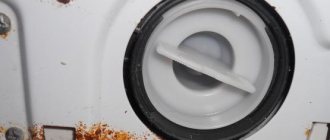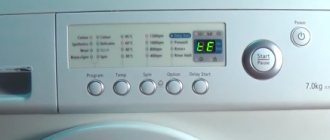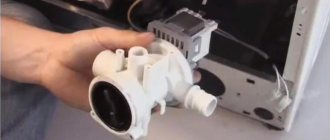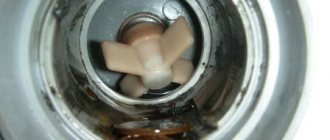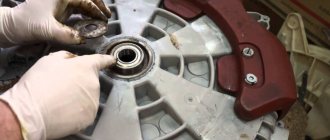Drain filter (drain)
If you have a front-loading washing machine, for example from Samsung, LG, Electrolux, Indesit or any other common brand, then finding a filter will be very easy. Take a closer look at the bottom of the washing machine. Usually you will see a rectangular or round cover in the lower right corner - this is where your filter is located. Some lids can simply be removed to reveal the filter, while others are childproof and require a screwdriver, plastic knife, or even a kitchen spoon to remove.
Some top-loading machines, such as Beko, Zanussi, Ardo, also have a lid in the bottom corner, but others, such as Bosch and Candy washing machines, have self-cleaning filters located under the drum. “Self-cleaning” means that most of the debris is washed away by the wastewater, so less dirt accumulates on the filter. And yet, the filter in such a modern machine should be checked at least once a year. This is easy to do - just remove the drum and you will see the filter cover located directly underneath, where the filter element is hidden.
The filter does not unscrew: what to do?
Most often, the drain filter can be unscrewed even without much effort, but if it has not been cleaned for many years, it can “stick.”
Unscrewing the part will not be so easy. Don't give up, the problem can be solved. Get ready to remove the entire structure along with the pump. To get to the filter element, you will need to lay the car on its side. Models such as LG, Samsung, Whirlpool, Candy, Indesit and Hotpoint Ariston have a removable bottom. For Bosch and Siemens, the front panel can be easily removed. In the case of Electrolux, you need to remove the back wall.
Unscrew the screws holding the drain device and carefully unscrew the filter from the inside. If this fails, get ready to disassemble the entire structure into individual elements. It is more convenient to do this on the table. Once the part is removed, remove any dirt from it and rinse it. Reassemble everything in reverse order and install the system in place.
Cleaning the drain filter
It is important to remember that before unscrewing the filter, you should drain all the water from the machine and unplug it .
- After you have opened the lid, place a container to catch any water that may leak from the tank.
- Turn the outer part of the filter counterclockwise until you can remove it completely.
- Use a paper towel to remove hair, threads, and lint from the filter.
- Place the filter in a bowl of hot water for 10 minutes to allow any residue that cannot be removed with a towel to sit in the hot water.
- Inspect the drain hose and try to clean it as much as possible.
- Wipe the inside of the drum and under the sealing lip of the hatch so that the lint that has accumulated there does not clog the newly cleaned filter.
- Once you are sure there is no dirt left in your filter, screw it back into the machine. If you removed the drain hose, be sure to put it back on before screwing in the filter.
- If the filter was under the drum, place it in place and secure the cover. Place the drum back on the filter and secure the drum nut and cap.
- After all the filters have been returned to their correct places, run your washing machine empty, without any clothes, to check the operation of the pumps. If the washing machine begins to leak, although it did not leak before the procedure, it means the filter is damaged or installed incorrectly. Drain the tank and try reinstalling the filter.
- If reinstalling the filter element does not eliminate the leak, contact a washing machine repair technician.
Can't unscrew
Sometimes it is not possible to unscrew and remove the filter due to various objects stuck in it. Hair, socks and handkerchiefs, coins, beads and other small items during washing can end up in the catcher in front of the pump and plug it. Limescale deposits on the threads, which occur if the filter has not been removed for a long time, can also become an obstacle.
In this case, there are three ways to open the garbage filter. Apply them in turn, proceeding to the next method only if you tried the previous one and it did not help. Before you begin, be sure to unplug the machine and close the valve to prevent water from flowing.
1 way. Use pliers or pliers to unscrew the filter cap. There is a handle on it that you need to try to turn using a tool. Manipulations should be carried out very carefully so as not to break the filter part.
Method 2. Lightly tap the drain pump filter cover several times while tilting the washing machine. This method is suitable when:
- The garbage filter cover does not rotate at all;
- partially rotates;
- It can be unscrewed, but it cannot be removed.
Tilt the machine back and lean it against the wall. Tap the dust filter cover and the housing next to it. If the snag is in small objects that have stopped the desired part, then the knock will cause them to move, and you can unscrew and pull out the filter.
3 way. If the previous two methods were unsuccessful, then you need to completely remove the drain pump. The task is to clean the snail and remove the filter. This method is quite complicated - you need to get to the pump, unhook the pump from the volute and through the resulting hole get to the filter.
The design features of certain models of Kandy washing machines allow the drainage pump to be dismantled through the bottom. If it is easily removed or is absent altogether, then it is easier and more convenient to get the snail with the pump in this way. Putting the machine on its side or simply tilting it in the desired direction and resting it on the wall, remove the bottom and find the pump. It is located behind the filter, that is, in the lower part of the housing.
The listed methods should only be used if you are confident in your abilities and have certain skills in repairing various devices. If the filter does not unscrew and you are not very well versed in technology, it is better to call a specialist. It must be remembered that through ignorance you can not only waste time, but also worsen the situation.
Interesting:
- Share your opinion - leave a comment
For complex household appliances, which includes a washing machine, preventive maintenance is necessary. Otherwise, active use will quickly damage the machine.
One type of regular equipment maintenance is cleaning the washing machine filter. It is needed for the normal operation of the drain pump. The filter serves as a barrier that protects the pump from foreign objects entering the tank, lint from fabrics, wool, hair and other debris. A clogged filter makes it difficult to pump water out of the tank and can cause pump failure.
Therefore, we have prepared an instructional article about cleaning the filter and the main problems that washing machine owners encounter during cleaning.
Cleaning the filler filter
In order to clean the inlet filter from dirt and foreign objects, it must be carefully pulled out, preferably with pliers. You should pull it out without tugging, since the part is fragile and in case of breakage cannot be repaired, but only replaced. Rinse the filter mesh with warm water and scrape off the accumulated dirt and plaque by hand or with an old toothbrush.
If after washing the mesh does not show through to the light, then it’s time to change it, or try soaking it in a descaling solution and cleaning it again. After washing, the filter is installed in the mounting hole and checked for leaks during the first wash.
The filter leaks after cleaning: reasons
It happens that after cleaning, the filter begins to let water through. As a result, a puddle forms on the floor under the machine. There are several reasons for this phenomenon:
- The filter is not level or the cap is not tightened completely. Unscrew the cover and try to install it again. The thread should go straight without distortion. There is no need to tighten the cap too much - the plastic part can easily be damaged or twisted.
- Gasket defect. The gasket ensures a tight fit of the lid to the opening of the machine. During operation, it may become unusable due to drying out or careless use. To eliminate the leak, you will need to replace this product. If the rubber band is not sold individually, the entire filter element will have to be replaced.
- Damage to thread or filter. The thread on the lid is plastic and can be easily damaged if handled carelessly. It is enough to apply too much force when unscrewing or tightening the lid. The threads can be damaged if the cover is installed unevenly. In both options, the contact of the lid with the threads of the machine becomes less tight, and water begins to ooze out. The situation can be corrected by replacing the cover paired with the snail.
How to install a filter in an automatic car
What functions does the filter perform in a washing machine?
The water entering the tank sometimes contains various inclusions and debris. If they accumulate on the internal surfaces of the pump, they can damage the device. The drain filter retains:
- impurities dissolved in water;
- mineral salts;
- lumps of dirt and grains of sand stuck to clothes;
- fibers of fabrics, pieces of wool;
- hair;
- small items forgotten in pockets;
- large particles of low-quality washing powder.
But without cleaning, this barrier stops working; debris does not allow water into the drain system, preventing it from leaving the tank. If foreign objects enter the pump, the risk of pump failure increases. Therefore, in order for the washing machine to last a long time, you need to regularly clean the filter for preventive purposes.
How to remove the filter: step-by-step instructions
Before cleaning, you need to perform a few simple steps. Water is removed from the device, the hatch is opened and the filter located behind it is removed. Depending on the model of the washing machine, manual force may be sufficient or you may need to use tools.
Removal using manual force
When you remove the filter, some water will flow out of the drain hole. Prepare a container for collecting it in advance and place a dry rag on the floor. If a malfunction occurs while washing clothes, they should be removed from the tub. The work sequence is as follows:
- Before removing the device, turn off the tap supplying water to the washing machine and remove the plug of the device from the electrical outlet.
- Then the panel covering the filter device is pulled out or the hatch installed in front of it is opened.
- The remaining water in the machine is removed with a rag. You can also drain the water into a low basin by slightly tilting the body of the device or using an emergency hose.
- After this, the filter cover is turned counterclockwise at an angle of no more than 60° to remove the remaining water.
- Then unscrew and take out the filter itself. If the design of the device has a plug that acts as a plug, first unscrew it.
Dismantling using tools
During your work, you may find that you cannot open the hatch cover with your hands. Carefully pry it open with a flathead screwdriver, being careful not to scratch the surface. The protective panel is installed on special latches. It can open sideways, parallel to the body of the machine (usually to the left), or forward.
Also use a screwdriver very carefully if you cannot move the panel by hand. Sometimes the screw holding it in place does not allow you to turn the cover to remove moisture. In this case, you need to loosen it a little using a screwdriver. If it is difficult to unscrew the filter with your fingers, try using pliers.
Act as delicately as possible so as not to break the part.
Via drain pump
If you cannot unscrew the filter according to the scheme described above, try to remove and clean it by removing it together with the water drain pump. This is a rather complicated method of removing blockages, so it is not advisable to use it in the absence of sufficient knowledge about the structure of a specific model of washing machine.
It is necessary to disconnect the pump volute from the electrical wires and pipes of the pump, to which it is attached with clamps or screws. In some machine models, the front or rear panel of the case is removed for this; in others, you can access the device through the bottom. To clean the filter, use the drain pipe hole. You can also remove dirt by separating the pump from the volute.
